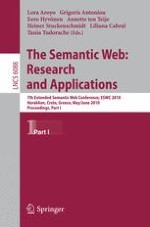This volume contains papers from the technical program of the 7th Extended Semantic Web Conference (ESWC 2010), held from May 30 to June 3, 2010, in Heraklion, Greece. ESWC 2010 presented the latest results in research and applications of Semantic Web technologies. ESWC 2010 built on the success of the former European Semantic Web Conference series, but sought to extend its focus by engaging with other communities within and outside Information and Communication Technologies, in which semantics can play an important role. At the same time, ESWC has become a truly international conference. Semantics of Web content, enriched with domain theories (ontologies), data about Web usage, natural language processing, etc., will enable a Web that p- vides a qualitatively new level of functionality. It will weave together a large network of human knowledge and make this knowledge machine-processable. Various automated services, based on reasoning with metadata and ontologies, will help the users to achieve their goals by accessing and processing infor- tion in machine-understandable form. This network of knowledge systems will ultimately lead to truly intelligent systems, which will be employed for va- ous complex decision-making tasks. Research about Web semantics can bene?t from ideas and cross-fertilization with many other areas: arti?cial intelligence, natural language processing, database and information systems, information - trieval, multimedia, distributed systems, social networks, Web engineering, and Web science.
